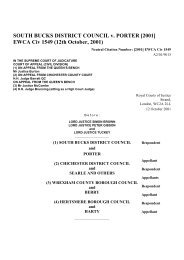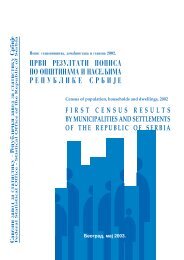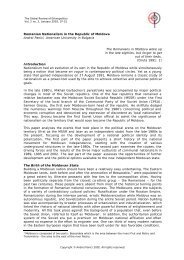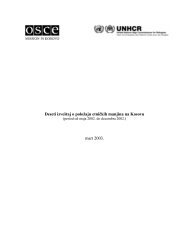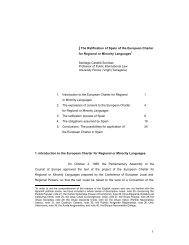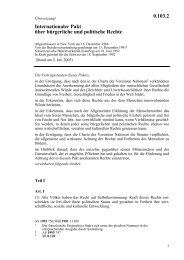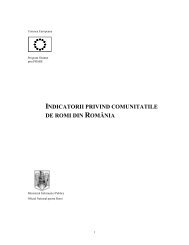Final Report of the International Commission on the - Minority Rights ...
Final Report of the International Commission on the - Minority Rights ...
Final Report of the International Commission on the - Minority Rights ...
You also want an ePaper? Increase the reach of your titles
YUMPU automatically turns print PDFs into web optimized ePapers that Google loves.
O<str<strong>on</strong>g>the</str<strong>on</strong>g>rs 22 968 Magyar 911 550<br />
Romanian 1 176 433<br />
German 68 694<br />
Jews 138 885<br />
O<str<strong>on</strong>g>the</str<strong>on</strong>g>rs 99 585 Magyar 1 347 012<br />
Romanian 1 066 353<br />
German 47 501<br />
Yiddish 45 593<br />
Ru<str<strong>on</strong>g>the</str<strong>on</strong>g>ne 20 609<br />
Slovak 20 908<br />
Romany 24 729<br />
O<str<strong>on</strong>g>the</str<strong>on</strong>g>rs 4 586<br />
Total 2 194 254 Total 2 395 147 Total 2 577 291<br />
Source: C. A. Macartney, October Fifteenth. A History <str<strong>on</strong>g>of</str<strong>on</strong>g> Modern Hungary, 1929-1945 (Edinburgh:<br />
Edinburgh University Press, 1957), Vol. 1, p. 423.:<br />
The census figures used in this table are dubious. Both <str<strong>on</strong>g>the</str<strong>on</strong>g> Hungarian and <str<strong>on</strong>g>the</str<strong>on</strong>g> Romanian census<br />
authorities appear to have juggled <str<strong>on</strong>g>the</str<strong>on</strong>g> figures relating to <str<strong>on</strong>g>the</str<strong>on</strong>g> ethnic and nati<strong>on</strong>al minorities in order to<br />
advance <str<strong>on</strong>g>the</str<strong>on</strong>g>ir particular nati<strong>on</strong>al interests with reference to <str<strong>on</strong>g>the</str<strong>on</strong>g>ir respective claims to <str<strong>on</strong>g>the</str<strong>on</strong>g> regi<strong>on</strong>. This was<br />
particularly true <str<strong>on</strong>g>of</str<strong>on</strong>g> <str<strong>on</strong>g>the</str<strong>on</strong>g> statistical treatment <str<strong>on</strong>g>of</str<strong>on</strong>g> <str<strong>on</strong>g>the</str<strong>on</strong>g> Jewish minority.<br />
Before <str<strong>on</strong>g>the</str<strong>on</strong>g> partiti<strong>on</strong>, <str<strong>on</strong>g>the</str<strong>on</strong>g> total Jewish populati<strong>on</strong> <str<strong>on</strong>g>of</str<strong>on</strong>g> Transylvania was about 200,000. Of <str<strong>on</strong>g>the</str<strong>on</strong>g>se,<br />
164,052 lived in <str<strong>on</strong>g>the</str<strong>on</strong>g> territories ceded to Hungary.<br />
The historical and cultural heritage that tied Transylvanian Jews to Hungary and <str<strong>on</strong>g>the</str<strong>on</strong>g> socioec<strong>on</strong>omic<br />
and political realities that bound <str<strong>on</strong>g>the</str<strong>on</strong>g>m to Romania were <str<strong>on</strong>g>the</str<strong>on</strong>g> source <str<strong>on</strong>g>of</str<strong>on</strong>g> many c<strong>on</strong>flicts during <str<strong>on</strong>g>the</str<strong>on</strong>g> interwar<br />
period. It is <strong>on</strong>e <str<strong>on</strong>g>of</str<strong>on</strong>g> <str<strong>on</strong>g>the</str<strong>on</strong>g> ir<strong>on</strong>ies and tragedies <str<strong>on</strong>g>of</str<strong>on</strong>g> history that after <str<strong>on</strong>g>the</str<strong>on</strong>g> divisi<strong>on</strong> <str<strong>on</strong>g>of</str<strong>on</strong>g> Transylvania in 1940 <str<strong>on</strong>g>the</str<strong>on</strong>g><br />
Jews fared far worse in <str<strong>on</strong>g>the</str<strong>on</strong>g> part allotted to Hungary – <str<strong>on</strong>g>the</str<strong>on</strong>g> country with which <str<strong>on</strong>g>the</str<strong>on</strong>g>y maintained so many<br />
cultural and emoti<strong>on</strong>al ties – than in <str<strong>on</strong>g>the</str<strong>on</strong>g> <strong>on</strong>e left with Romania – <str<strong>on</strong>g>the</str<strong>on</strong>g> state identified with many anti-<br />
Semitic excesses in <str<strong>on</strong>g>the</str<strong>on</strong>g> course <str<strong>on</strong>g>of</str<strong>on</strong>g> its history.<br />
The Jews <str<strong>on</strong>g>of</str<strong>on</strong>g> Transylvania were victims <str<strong>on</strong>g>of</str<strong>on</strong>g> <str<strong>on</strong>g>the</str<strong>on</strong>g> historical milieu in which <str<strong>on</strong>g>the</str<strong>on</strong>g>y lived. Romanians<br />
resented <str<strong>on</strong>g>the</str<strong>on</strong>g>m because <str<strong>on</strong>g>of</str<strong>on</strong>g> <str<strong>on</strong>g>the</str<strong>on</strong>g>ir proclivity to Hungarian culture and by implicati<strong>on</strong> Hungarian revisi<strong>on</strong>ism<br />
and irredentism. Hungarians, especially Right radicals, accused <str<strong>on</strong>g>the</str<strong>on</strong>g>m <str<strong>on</strong>g>of</str<strong>on</strong>g> being “renegades” in <str<strong>on</strong>g>the</str<strong>on</strong>g> service<br />
<str<strong>on</strong>g>of</str<strong>on</strong>g> <str<strong>on</strong>g>the</str<strong>on</strong>g> Left.<br />
The socioec<strong>on</strong>omic structure <str<strong>on</strong>g>of</str<strong>on</strong>g> Transylvanian Jewry was similar to that <str<strong>on</strong>g>of</str<strong>on</strong>g> <str<strong>on</strong>g>the</str<strong>on</strong>g> Jews in <str<strong>on</strong>g>the</str<strong>on</strong>g><br />
neighboring provinces. Many were engaged in business or trade, and <str<strong>on</strong>g>the</str<strong>on</strong>g>ir percentage in <str<strong>on</strong>g>the</str<strong>on</strong>g> pr<str<strong>on</strong>g>of</str<strong>on</strong>g>essi<strong>on</strong>s<br />
and white-collar fields outside <str<strong>on</strong>g>of</str<strong>on</strong>g> government was relatively high. There were, however, <strong>on</strong>ly a handful <str<strong>on</strong>g>of</str<strong>on</strong>g><br />
Jews associated with mining and heavy industry. While no data <strong>on</strong> income distributi<strong>on</strong> are available, <str<strong>on</strong>g>the</str<strong>on</strong>g><br />
many studies <strong>on</strong> Transylvania reveal that <str<strong>on</strong>g>the</str<strong>on</strong>g>re was a c<strong>on</strong>siderable proporti<strong>on</strong> <str<strong>on</strong>g>of</str<strong>on</strong>g> Jews who could barely<br />
make a living; many depended for <str<strong>on</strong>g>the</str<strong>on</strong>g>ir survival <strong>on</strong> <str<strong>on</strong>g>the</str<strong>on</strong>g> generosity <str<strong>on</strong>g>of</str<strong>on</strong>g> <str<strong>on</strong>g>the</str<strong>on</strong>g> community. Most <str<strong>on</strong>g>of</str<strong>on</strong>g> <str<strong>on</strong>g>the</str<strong>on</strong>g>se<br />
impoverished Jews lived in <str<strong>on</strong>g>the</str<strong>on</strong>g> densely populated Jewish centers <str<strong>on</strong>g>of</str<strong>on</strong>g> <str<strong>on</strong>g>the</str<strong>on</strong>g> northwest.<br />
The original reacti<strong>on</strong> <str<strong>on</strong>g>of</str<strong>on</strong>g> many <str<strong>on</strong>g>of</str<strong>on</strong>g> <str<strong>on</strong>g>the</str<strong>on</strong>g> North Transylvanian Jews to <str<strong>on</strong>g>the</str<strong>on</strong>g> historical changes in <str<strong>on</strong>g>the</str<strong>on</strong>g> regi<strong>on</strong><br />
was to a large extent determined by <str<strong>on</strong>g>the</str<strong>on</strong>g>ir experiences during <str<strong>on</strong>g>the</str<strong>on</strong>g> previous three years, when <str<strong>on</strong>g>the</str<strong>on</strong>g> various<br />
Romanian governments instituted a series <str<strong>on</strong>g>of</str<strong>on</strong>g> anti-Semitic measures, and <str<strong>on</strong>g>the</str<strong>on</strong>g> memories <str<strong>on</strong>g>the</str<strong>on</strong>g>y still nurtured<br />
about <str<strong>on</strong>g>the</str<strong>on</strong>g>ir lives in <str<strong>on</strong>g>the</str<strong>on</strong>g> Austro-Hungarian Empire. The illusi<strong>on</strong>s cherished by many am<strong>on</strong>g <str<strong>on</strong>g>the</str<strong>on</strong>g>se Jews that<br />
<str<strong>on</strong>g>the</str<strong>on</strong>g> Hungarian annexati<strong>on</strong> <str<strong>on</strong>g>of</str<strong>on</strong>g> <str<strong>on</strong>g>the</str<strong>on</strong>g> area would denote a return to <str<strong>on</strong>g>the</str<strong>on</strong>g> “Golden Era” so<strong>on</strong> gave way to<br />
disbelief and despair. The newly established Hungarian authorities lost no time in implementing <str<strong>on</strong>g>the</str<strong>on</strong>g> anti-<br />
Jewish laws and policies that had already been in effect in Hungary proper. The Jewish newspapers were



